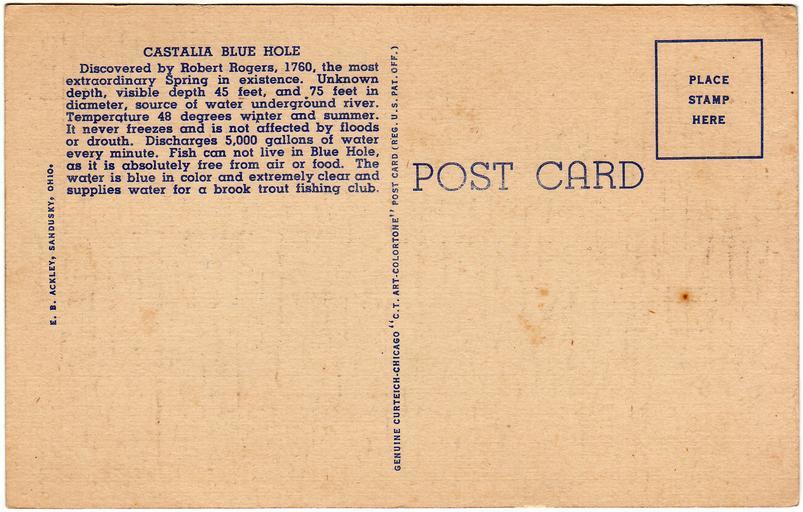MAKE A MEME
View Large Image

| View Original: | Back_of_Mill_Pond_and_Fish_Hatchery,_Blue_Hole,_Castalia,_Ohio_(Date_Unknown).jpg (1687x1076) | |||
| Download: | Original | Medium | Small | Thumb |
| Courtesy of: | www.flickr.com | More Like This | ||
| Keywords: castalia castalia, ohio castaliaohio blue hole bluehole the blue hole thebluehole pond ponds tourist sites touristsites linen c.t. art-colortone ctartcolortone curteich-chicago curteichchicago curteich e.b. ackley ebackley date unknown dateunknown postcard postcards divided back dividedback white border whiteborder white border era whiteborderera text Description on front of card: Mill Pond and Fish Hatchery, Blue Hole, Castalia, Ohio No. in Series: 31 Publisher: E.B. Ackley, Sandusky, Ohio; Genuine Curteich-Chicago "C.T. Art-Colortone" post card, a tradename under Curt Teich Co., Chicago, Illinois Date: Unknown The Blue Hole is a freshwater pond and was a tourist site from the 1920s to 1990 and had 165,000 visitors annually. Wikipedia: en.wikipedia.org/wiki/Blue_Hole_(Castalia) Publisher/Distributor Notes: Eugene B. Ackley (1871-1957) was a musician and band leader in Sandusky, Ohio. He also taught music at Sandusky High School. The photos and images were created by E.B. Ackley, but the cards were printed en masse by the Curt Teich Company in Chicago, Ill., under the trade name, "C.T. Art-Colortone." Sources: sanduskyhistory.blogspot.com/2006/12/eb-ackley-musician-b... sanduskyhistory.blogspot.com/2013/08/ohios-lake-erie-vaca... Curt Teich emigrated to Chicago in 1895. He had worked as a lithographer in Lobenstein, Germany. He founded the Curt Teich Company in 1898, concentrating on newspaper and magazine printing. He was an early publisher of postcards, but he didn't begin printing them himself until 1908. According to MetroPostcard.com, "As his competition dwindled, his sales expanded and his American factories would eventually turn out more postcards than any other in the United States. " The company was best known for their wide range of advertising and postcards of North America. By the 1920s, it was producing so many postcards with borders that they became recognized as a type dubbed "White Border Cards," creating an "era." Curt Teich started using offset presses in 1907, but it took a number of years before he had offset presses made to his satisfaction, and many more years for him to perfect the method. His innovations in this printing technique directly led to the production of what we now call "linens" by the early 1930s. The company aided the war effort during the second world war by also printing many military maps. Curt Teich eventually turned management of the company over to his son, but he remained active in company operations throughout its history. Curt Teich died in 1974 and the family business was sold to Regensteiner Publishers who continued to print postcards at the Chicago plant until 1978 when the rights to the company name and processes were sold to the Irish company, John Hinde Ltd. Their California subsidiary now prints postcards under the name John Hinde Curteich, Inc. Source: www.metropostcard.com/publisherst.html Description on front of card: Mill Pond and Fish Hatchery, Blue Hole, Castalia, Ohio No. in Series: 31 Publisher: E.B. Ackley, Sandusky, Ohio; Genuine Curteich-Chicago "C.T. Art-Colortone" post card, a tradename under Curt Teich Co., Chicago, Illinois Date: Unknown The Blue Hole is a freshwater pond and was a tourist site from the 1920s to 1990 and had 165,000 visitors annually. Wikipedia: en.wikipedia.org/wiki/Blue_Hole_(Castalia) Publisher/Distributor Notes: Eugene B. Ackley (1871-1957) was a musician and band leader in Sandusky, Ohio. He also taught music at Sandusky High School. The photos and images were created by E.B. Ackley, but the cards were printed en masse by the Curt Teich Company in Chicago, Ill., under the trade name, "C.T. Art-Colortone." Sources: sanduskyhistory.blogspot.com/2006/12/eb-ackley-musician-b... sanduskyhistory.blogspot.com/2013/08/ohios-lake-erie-vaca... Curt Teich emigrated to Chicago in 1895. He had worked as a lithographer in Lobenstein, Germany. He founded the Curt Teich Company in 1898, concentrating on newspaper and magazine printing. He was an early publisher of postcards, but he didn't begin printing them himself until 1908. According to MetroPostcard.com, "As his competition dwindled, his sales expanded and his American factories would eventually turn out more postcards than any other in the United States. " The company was best known for their wide range of advertising and postcards of North America. By the 1920s, it was producing so many postcards with borders that they became recognized as a type dubbed "White Border Cards," creating an "era." Curt Teich started using offset presses in 1907, but it took a number of years before he had offset presses made to his satisfaction, and many more years for him to perfect the method. His innovations in this printing technique directly led to the production of what we now call "linens" by the early 1930s. The company aided the war effort during the second world war by also printing many military maps. Curt Teich eventually turned management of the company over to his son, but he remained active in company operations throughout its history. Curt Teich died in 1974 and the family business was sold to Regensteiner Publishers who continued to print postcards at the Chicago plant until 1978 when the rights to the company name and processes were sold to the Irish company, John Hinde Ltd. Their California subsidiary now prints postcards under the name John Hinde Curteich, Inc. Source: www.metropostcard.com/publisherst.html | ||||